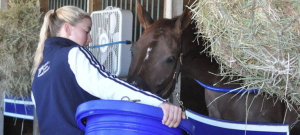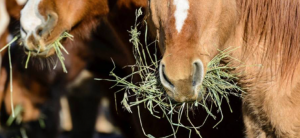 Avoiding Colic as Horses Transition from Pasture to Hay: It happens every year. Horses that have been turned out in pastures all summer must transition to a diet that contains far less fresh grass and far more hay. This means that the important fiber portion of the diet will have a lower moisture content along with a significant increase in the percentage of dry matter. Read further to learn how to avoid colic as horses transition from pasture to hay.
Avoiding Colic as Horses Transition from Pasture to Hay: It happens every year. Horses that have been turned out in pastures all summer must transition to a diet that contains far less fresh grass and far more hay. This means that the important fiber portion of the diet will have a lower moisture content along with a significant increase in the percentage of dry matter. Read further to learn how to avoid colic as horses transition from pasture to hay.
Throughout the fall and winter months, owners should continue to allow as much turnout as possible. Any change to a horse’s diet should be made as gradually as possible in order to avoid colic and other digestive tract upsets. Fortunately for horse owners, the move from grass to hay naturally follows this pattern as pasture growth declines and plants enter a dormant stage. Horses that have access to pasture will continue to graze, but the forage they ingest will slowly drop in moisture and lose its fresh characteristics.
Water is Essential:
Providing plenty of fresh, clean water is essential in every season, but it is particularly important when hay is being fed and horses are not getting much moisture from their forage intake. Extremely cold water is less appealing than water that has been warmed to around 50° F. Water at this temperature still feels very cold on human skin, but it is readily consumed by horses.
Access to salt, either loose or in a block, is also important. Sprinkling a bit of salt on grain or dampened hay will stimulate the horse to drink more water.
Exercise and Consumption:
Throughout the fall and winter months, owners should continue to allow as much turnout as possible. According to Kathleen Crandell, Ph.D., senior equine nutritionist at Kentucky Equine Research, “Exercise helps to keep ingested material moving through the horse’s digestive tract. Pastured horses cover a lot more ground than stalled horses. Especially if they are turned out with a buddy or two.” If outdoor exercise isn’t available, be sure that all horses get at least a few hours of riding, driving, longeing, or free exercise in a covered arena each day.
Monitor hay consumption while horses are in their stalls. If one horse is not consuming much hay, or if you find wads of partially chewed hay lying on the floor in this horse’s stall, he may need to have his teeth checked. Dental exams should be scheduled for all horses once or twice a year. Some horses, especially older equine, can develop problems between checkups.
Hay and Supplements:
When a new batch of hay is delivered, introduce it by feeding a small amount of the new hay mixed into the old. Increase the percentage of new hay gradually over five to seven days. This allows the microbes in the horse’s gut to adjust to the change and prevents upsets.
Inspect each bale of hay as it is opened. Discard any hay that smells musty or shows signs of mold. Most horses will refuse to eat hay that is moldy. Even if the mold is so slight that humans can’t detect it. However, extremely hungry horses may eat tainted hay. It should never be fed and should be disposed of in an area where horses can’t reach it.
Research-proven digestive supplements can help horses that are prone to colic during feed transitions. EquiShure, a supplement developed by Kentucky Equine Research, stabilizes the pH of the hindgut. Changes in feed sometimes cause the pH to fluctuate wildly, which can set the stage for colic or laminitis.
Would you like more information about hay diets and how to avoid colic as horses transition from pasture to hay? Contact us at J & J Farms by clicking here!
Article brought to you by KER.

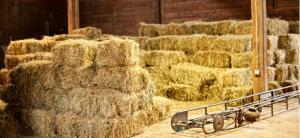 The color of horse hay is very useful in determining the quality of the hay. Methods of curing and storing hay greatly influence its appropriateness for horses.
The color of horse hay is very useful in determining the quality of the hay. Methods of curing and storing hay greatly influence its appropriateness for horses.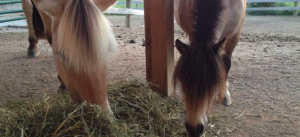 An age-old question: when is feeding old hay to horses O.K.?
An age-old question: when is feeding old hay to horses O.K.?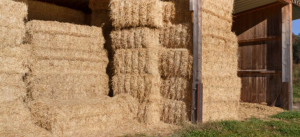 Cultivating good-quality hay is no easy task and is dependent on cooperative weather for optimal success. Hay farmers must keep a keen eye on plant growth, the moisture content at harvest, and other baling considerations in order to avoid moldy hay for horses. Mold forms on hay because of excessive moisture, which is why it is so critical to harvest hay under the most conducive conditions and then store it properly once baled.
Cultivating good-quality hay is no easy task and is dependent on cooperative weather for optimal success. Hay farmers must keep a keen eye on plant growth, the moisture content at harvest, and other baling considerations in order to avoid moldy hay for horses. Mold forms on hay because of excessive moisture, which is why it is so critical to harvest hay under the most conducive conditions and then store it properly once baled.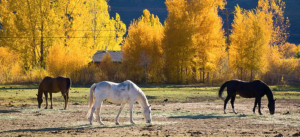 As autumn shifts to winter, or summer droughts begin to set in, horse owners in many climates must provide horses with an appropriate alternative forage to fulfill fiber requirements. In most cases, this involves switching to hay, haylage, or hay cubes.
As autumn shifts to winter, or summer droughts begin to set in, horse owners in many climates must provide horses with an appropriate alternative forage to fulfill fiber requirements. In most cases, this involves switching to hay, haylage, or hay cubes.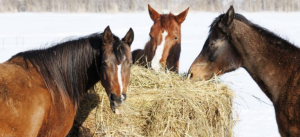 With winter approaching, horse owners will be looking for a source of hay to feed
With winter approaching, horse owners will be looking for a source of hay to feed 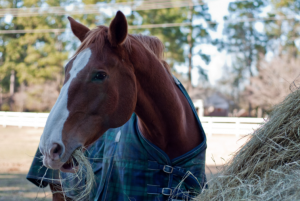 As the warm summer months draw to a close, horse owners stock up on hay for the winter. The hay man has a variety of hays available, including the yellow or brown, less leafy fall hays. Although they might not be as physically attractive and green as the hay harvested earlier in the summer, there are many benefits to late-season hay for horses.
As the warm summer months draw to a close, horse owners stock up on hay for the winter. The hay man has a variety of hays available, including the yellow or brown, less leafy fall hays. Although they might not be as physically attractive and green as the hay harvested earlier in the summer, there are many benefits to late-season hay for horses.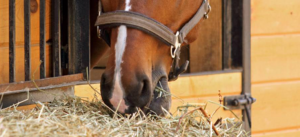 Common hays fed to horses include various pure grass hays, mixed grass hays, and legume hays such as alfalfa (lucerne) and clover. If these hays are not available, horse owners may have to choose alternative hays from less traditional hay types. While these other forages are usually suitable for horses, some have associated risks.
Common hays fed to horses include various pure grass hays, mixed grass hays, and legume hays such as alfalfa (lucerne) and clover. If these hays are not available, horse owners may have to choose alternative hays from less traditional hay types. While these other forages are usually suitable for horses, some have associated risks.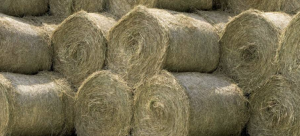 hay for your horse has much to do with his metabolism. Is your horse an easy keeper that requires few calories to stay in fighting weight? Or, is he a hard doer that demands calorie-laden meals to maintain reasonable body condition? Perhaps he is of moderate metabolism—if he’s fed normal fare in standard amounts, he’s good to go. What’s a horse owner to do when it comes to pairing metabolism with hay selection? Use these general tips to find a suitable hay for your horse.
hay for your horse has much to do with his metabolism. Is your horse an easy keeper that requires few calories to stay in fighting weight? Or, is he a hard doer that demands calorie-laden meals to maintain reasonable body condition? Perhaps he is of moderate metabolism—if he’s fed normal fare in standard amounts, he’s good to go. What’s a horse owner to do when it comes to pairing metabolism with hay selection? Use these general tips to find a suitable hay for your horse.